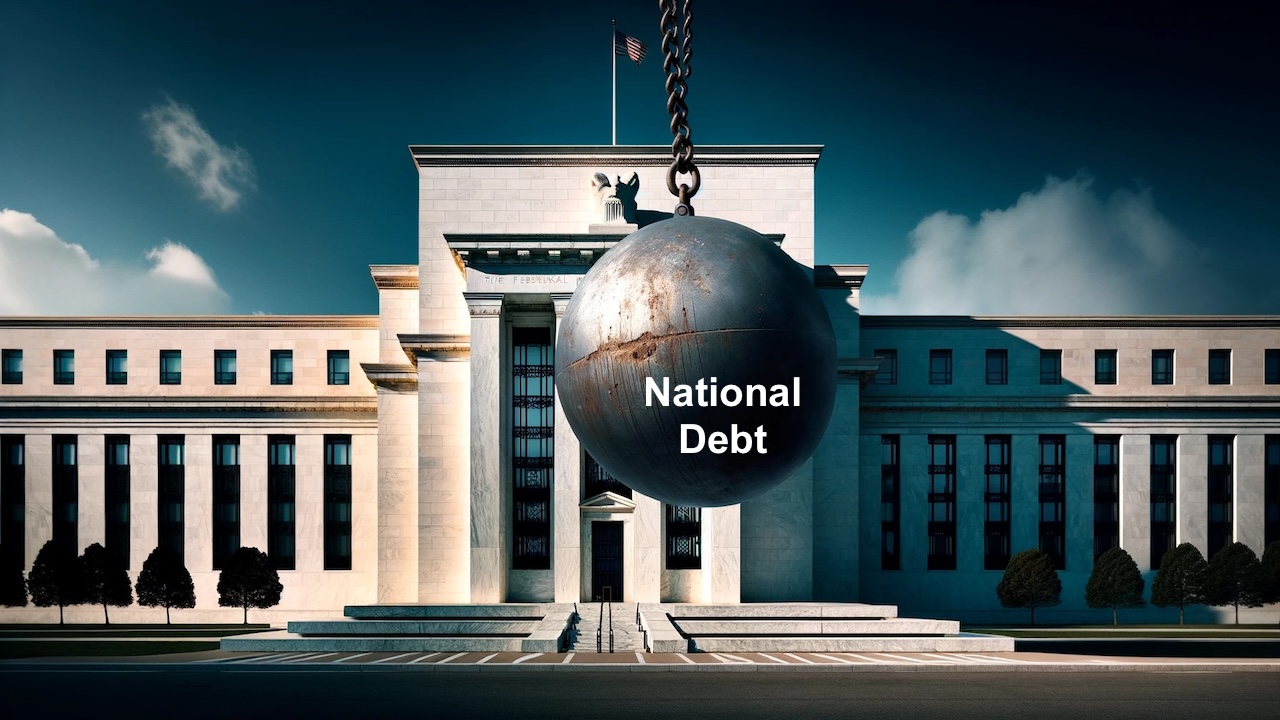The Federal Reserve has a $34.5 trillion problem.
And the problem is growing.
Yes, I’m talking about the national debt.
How is the debt the Fed’s problem?
It hamstrings the Fed’s ability to fight price inflation.
In a recent interview, Crescat Capital macro strategist Tavi Costa told Kitco News that soaring debt levels could ultimately render the central bank “powerless” and “irrelevant” in the inflation fight.
That’s because the two primary weapons the Fed uses against price inflation are interest rate increases and balance sheet reductions. Both become increasingly difficult to wield as the national debt spirals upward.
"At some point, the debt problem is going to be so large... that will cause the Fed to become almost irrelevant because they can't raise rates,” Costa said.
Every day that interest rates stay elevated raises the U.S. government’s borrowing cost. Rising interest rates drove Uncle Sam’s interest payments to over 35 percent as a percentage of total tax receipts in fiscal 2023. In other words, the government is already paying more than a third of the taxes it collects on interest expenses, and those interest payments are rising every month.
The federal government spent $288.01 billion in interest expense to finance the national debt in the first quarter of fiscal 2024. That was more than national defense ($238 billion) and more than Medicare ($168 billion). The only higher spending category was Social Security at $351 billion.
And yet the borrowing and spending continues.
The Biden administration blows through over half a trillion dollars every single month. The national debt eclipsed $34 trillion for the first time on Dec. 29. It grew by a half-trillion dollars in less than five months. This is a massive amount of fiscal stimulus during a time when the economy is growing normally and employment is strong. Costa said, “There is no reason to see this level of spending outside of the political reasons of elections coming and so forth," adding that the spending is “feeding a structural inflationary problem.”
“There are many inflationary structural pillars … but one of the main ones is reckless fiscal spending.”
The Federal Reserve Knows Borrowing and Spending Is a Problem
This is no secret to the Federal Reserve. In fact, a 2022 paper published by the Kansas City Fed admits the central bank can’t fight price inflation with monetary policy alone.
Federal Reserve Bank of Chicago economist Leonardo Melosi and John Hopkins University economist Francesco Bianchi authored the paper. In the abstract, they state, “This increase in inflation could not have been averted by simply tightening monetary policy.”
In a nutshell, federal government fiscal policy adds to inflationary pressures and makes it more difficult for the Fed to effectively wield its monetary policy weapons.
“Trend inflation is fully controlled by the monetary authority only when public debt can be successfully stabilized by credible future fiscal plans. When the fiscal authority is not perceived as fully responsible for covering the existing fiscal imbalances, the private sector expects that inflation will rise to ensure sustainability of national debt. As a result, a large fiscal imbalance combined with a weakening fiscal credibility may lead trend inflation to drift away from the long-run target chosen by the monetary authority.” [Emphasis added]
In this paper – published by the Fed – the authors concede that merely tinkering with interest rates won’t slay inflation if the government continues to spend far beyond its means.
Also, notice that Melosi and Bianchi admit that the government depends on inflation to enable borrowing and spending. In other words, Uncle Sam leans heavily on the inflation tax.
The federal government not only depends on the central bank to keep its borrowing costs down by suppressing interest rates, but it also counts on the Fed to enable its spending spree by soaking up some of the debt.
The U.S. Treasury depends on the Fed putting its big fat thumb on the bond market in order to facilitate government borrowing. As the central bank buys bonds through quantitative easing, it creates artificial demand and holds interest rates artificially low. This allows the U.S. Treasury to issue more bonds than it otherwise could at a lower interest cost.
And how does the Fed pay for these bonds?
By printing money.
The central bank doesn’t literally print $100 bills in the basement of the Eccles Building, but the effect is the same. The Fed creates digital money, sends it to the seller, takes possession of the bonds, and then holds the Treasuries on its balance sheet. This process is called “debt monetization.”
Without the central bank's mechanizations, the U.S. government wouldn't be able to borrow and spend to the extent that it does. Congress wouldn't be able to sustain deficits running in the trillions of dollars year after year. Instead, it would have to rely on direct taxation and borrowing smaller amounts for shorter terms. Because higher taxes are politically untenable, the government would be forced to constrain its spending, putting a natural check on both the warfare and the welfare state.
But with the Federal Reserve monetary operation in play, the government can borrow and spend far more than it otherwise could. And that means the government is bigger than it otherwise would be.
Melosi and Bianchi also tacitly admit that the Fed isn’t going to win this inflation fight and warn we could be heading toward stagflation.
"When fiscal imbalances are large and fiscal credibility wanes, it may become increasingly harder for the monetary authority to stabilize inflation around its desired target. If the monetary authority increases rates in response to high inflation, the economy enters a recession, which increases the debt-to-GDP ratio. If the monetary tightening is not supported by the expectation of appropriate fiscal adjustments, the deterioration of fiscal imbalances leads to even higher inflationary pressure. As a result, a vicious circle of rising nominal interest rates, rising inflation, economic stagnation, and increasing debt would arise.”
The Fed paper authors called it “a pathological situation.”
“Monetary tightening would actually spur higher inflation and would spark a pernicious fiscal stagflation, with the inflation rate drifting away from the monetary authority’s target and with GDP growth slowing down considerably.”
This is exactly what is happening. The latest GDP data shows economic growth slowing and price inflation pressures rising.

About the Author:
Mike Maharrey is a journalist and market analyst for MoneyMetals.com with over a decade of experience in precious metals. He holds a BS in accounting from the University of Kentucky and a BA in journalism from the University of South Florida.





